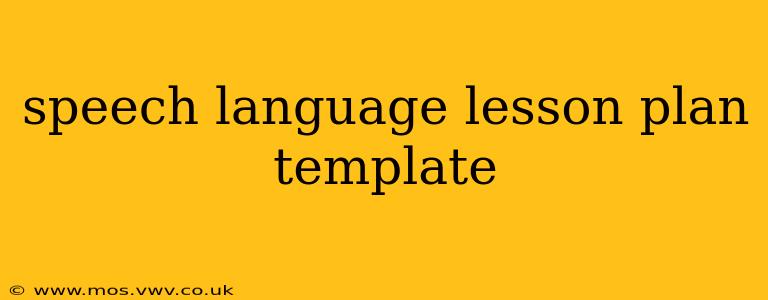This comprehensive speech-language lesson plan template provides a framework for creating engaging and effective therapy sessions. It’s designed to be adaptable for various age groups and speech-language goals. Remember to always tailor the plan to the individual needs and abilities of your client.
I. Client Information:
- Name:
- Date of Birth:
- Date of Session:
- Diagnosis/Referral:
- Current Goals (Short-Term & Long-Term): Clearly define specific, measurable, achievable, relevant, and time-bound (SMART) goals. Examples: Increase articulation accuracy of /s/ in single words to 90% accuracy, Improve expressive language skills by expanding sentence length to 5-7 words.
II. Session Objectives:
- Specific and Measurable Objectives: State what the client will be able to do by the end of the session. These should directly relate to the overall goals. Example: Client will correctly produce the /s/ sound in 8 out of 10 trials.
III. Materials:
- List all materials needed for the session. Be specific! Examples: Picture cards of animals, Articulation cards, Board game, Storybook, Bubbles. Include any technology used (apps, software).
IV. Session Procedures:
This section is the core of your lesson plan. Break down the session into smaller, manageable activities. Include details on how you will implement each activity, and how you will monitor the client's progress.
-
Warm-up Activity (5-10 minutes): Start with a fun, engaging activity to build rapport and prepare the client for the session. Examples: Singing songs, Playing a simple game, Reviewing previously learned material.
-
Targeted Activities (20-30 minutes): These are the main activities focused on achieving the session objectives. Be detailed here! Example:
- Activity 1: /s/ sound production in isolation. Use visual cues and tactile prompts to elicit the /s/ sound. Provide positive reinforcement.
- Activity 2: /s/ sound production in words. Use picture cards to target the /s/ sound in various word positions (initial, medial, final).
- Activity 3: /s/ sound production in phrases and sentences. Gradually increase complexity of the language used.
-
Reinforcement and Feedback (5-10 minutes): Provide positive reinforcement throughout the session. Give specific feedback on the client's performance, focusing on both successes and areas for improvement.
-
Cool-down Activity (5 minutes): End the session with a relaxing activity to help the client transition out of therapy. Examples: Reading a book, Playing a calming game.
V. Data Collection:
- How will you track progress towards the session objectives? Example: Record the number of correct responses for each activity. Use a data sheet or app to systematically track progress.
VI. Home Practice:
- Assign homework activities: Provide specific, manageable tasks for the client to practice at home. Explain clearly to the client and their caregivers how to complete these tasks.
VII. Modifications and Adaptations:
- Describe any modifications or adaptations you might make based on the client’s performance during the session. Be prepared to adjust activities based on the client’s response. This might involve simplifying activities, providing more support, or increasing the challenge.
VIII. Post-Session Notes:
- Summarize the session: Record the client's performance, any challenges encountered, and any changes made to the lesson plan. Note any relevant observations about the client's behavior, motivation, or communication style.
Example of a Targeted Activity:
Activity: Improving Narrative Skills
Objective: Client will tell a coherent 5-sentence story using appropriate vocabulary and grammar.
Procedure:
- Show picture cards depicting a sequence of events. (e.g., a child going to the park, playing on the swings, eating a snack, sliding down the slide, going home).
- Model telling a story based on the pictures. Use descriptive language and emphasize sentence structure.
- Have the client retell the story. Provide prompts and support as needed.
- Focus on sentence structure, vocabulary, and sequencing. Provide specific feedback and correction.
- Repeat with different picture sequences.
This template provides a robust structure. Remember to be flexible and adapt it to meet the unique needs of each client. Consistent use of this template will improve your efficiency and the effectiveness of your speech-language therapy sessions.
